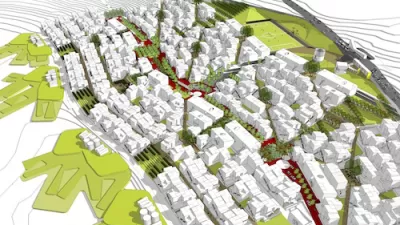Infrastructure
Efforts to Boost Walkability Meet Hostility in Twin Cities’ Suburbs
A fragmented network of sidewalks is commonplace in the suburbs of Hennepin County, Minnesota. Mary Jane Smetanka reports on controversial efforts to fill in the gaps and retrofit these suburban neighborhoods as walkable places.
A Streetcar to Desire: An Argument for Converting Roads to Rails
Terra Nova author Eric W. Sanderson builds a refreshingly wonky case for a modern streetcar revival.
New York Plans $20 Billion Battle Against Climate Change
On Tuesday, Mayor Bloomberg outlined an ambitious $20 billion plan to adapt New York City's infrastructure and built and natural environments to respond to the threats of rising seas and extreme storms.
Old-Age Adaptation: Our Next Great Urban Challenge
Americans are living longer and changing the demographic profiles of our cities in the process. Planners are just beginning to understand how our streets and systems must adapt to accommodate this trend.
Finding Room for a Million More New Yorkers
New York City's population is expected to grow by one million residents by 2040. But where can housing be built to accommodate all these new residents? A new report from a Columbia University think tank identifies the most promising candidates.
Four Options to Keep the Highway Trust Fund Solvent
MAP-21 expires on September 30, 2014. The following year, the Highway Trust Fund will be insolvent according to the CBO. Alternatives involve user fees paid by motorists: the gas tax and VMT fee, and two others that bear no connection to driving.
L.A. Bike Share Missing in Action; Is New City Ordinance to Blame?
Amid the hoopla over the recent launch of bike-share systems in two of the three largest cities in the U.S., the supposed start of such a system in the nation's second largest city has come and gone without any explanation. What's behind the delay?
Gas Tax Woes: A Tale of Two New England States
As states struggle with ways to increase transportation revenue to shore-up aging infrastructure, we look at Conn. and N.H. Due to indexing, one will increase its gas tax by 4-cents on July 1, while the other rejected a 12-cent increase over 3 years.
Could a Petition Sway the U.S. DOT to Change Its Ancient Road Classification System?
US Department of Transportation (DOT) officials would consider a change in the way they classify thoroughfares — to the benefit of pedestrians, bicyclists, and transit users — but they need political support, writes Robert Steuteville.
Ads That Actually Add Something to the Public Realm
Billboards deployed by IBM in France actually make themselves useful as they invade public spaces, and seek to inspire ideas for improving cities.

'Mr. Mayor, Tear Down This Freeway', Says San Francisco Planning Think Tank
In their June magazine, SPUR proposes a bold vision for transforming several San Francisco neighborhoods based on three big moves: tear down the end of Interstate 280, put Caltrain and high-speed rail underground, and redevelop the Caltrain railyard.
Station Fail: Citi Bike's Major Malfunction
Software problems delayed the launch of New York City's bike share program for nearly a year. Now that the system has launched, technical problems persist. Will they threaten its success?
After a Slow Start, Can the BeltLine Speed a Culture Shift in Atlanta?
Much to the chagrin of those who partake in the city's congested commute, cars dominate as Atlantans' prime means of mobility. The city's wildly ambitious BeltLine project seeks to change this, but can it be built fast enough to have an impact?
Two Pessimistic Outlooks on Fixing the Nation's Bridges
Brian Naylor of NPR and Stephen Lee Davis of Transportation for America examine different aspects of the government's inability to ensure that bridges are in a state of good repair.
Google Blimps to Bring Internet Access to Remote Regions
With the privacy concerns that've arisen with its questionable data gathering, many people are unlikely to welcome the idea of a Google blimp floating overhead. But the billion people the company wants to connect to the Internet may feel differently.
British Columbia Rejects Massive Northern Gateway Oil Pipeline
The rejection may ultimately doom the $6 billion pipeline to transport Alberta's oil sands crude west through British Columbia for export. Final word is reserved for Prime Minister Stephen Harper, but many say an overturn would be highly unusual.
The One About the Parking-Pinched Merchant…
Small business owners who drive themselves nuts arguing against the reuse of on-street parking with other balanced transportation solutions is a shame because there is so much good data to prove it's actually very good for business.
Moscow Gives Biking a Go
While the launch of NYC's bike share program was all the rage in the U.S. last week, Moscow began a program of its own with 220 red bikes at 30 stations. Sally McGrane frames it more as a 'triumph for political activism' than a commuting revolution.
Removing the Obstacles to Infilling Los Angeles
City leaders from the Mayor on down recognize that infill development is necessary to create a more livable Los Angeles. So why does the public sector allow so many obstacles to stand in the way of small-scale development?

Rwandan Town Takes Top Honors at CNU Charter Awards
A student project to radically rethink housing projects on New York’s Lower East Side and a holistic approach to a Rwandan village took top honors at the 2013 CNU Charter Awards, announced this week at CNU 21 in Salt Lake City.
Pagination
Urban Design for Planners 1: Software Tools
This six-course series explores essential urban design concepts using open source software and equips planners with the tools they need to participate fully in the urban design process.
Planning for Universal Design
Learn the tools for implementing Universal Design in planning regulations.
Gallatin County Department of Planning & Community Development
Heyer Gruel & Associates PA
JM Goldson LLC
City of Camden Redevelopment Agency
City of Astoria
Transportation Research & Education Center (TREC) at Portland State University
Jefferson Parish Government
Camden Redevelopment Agency
City of Claremont


































